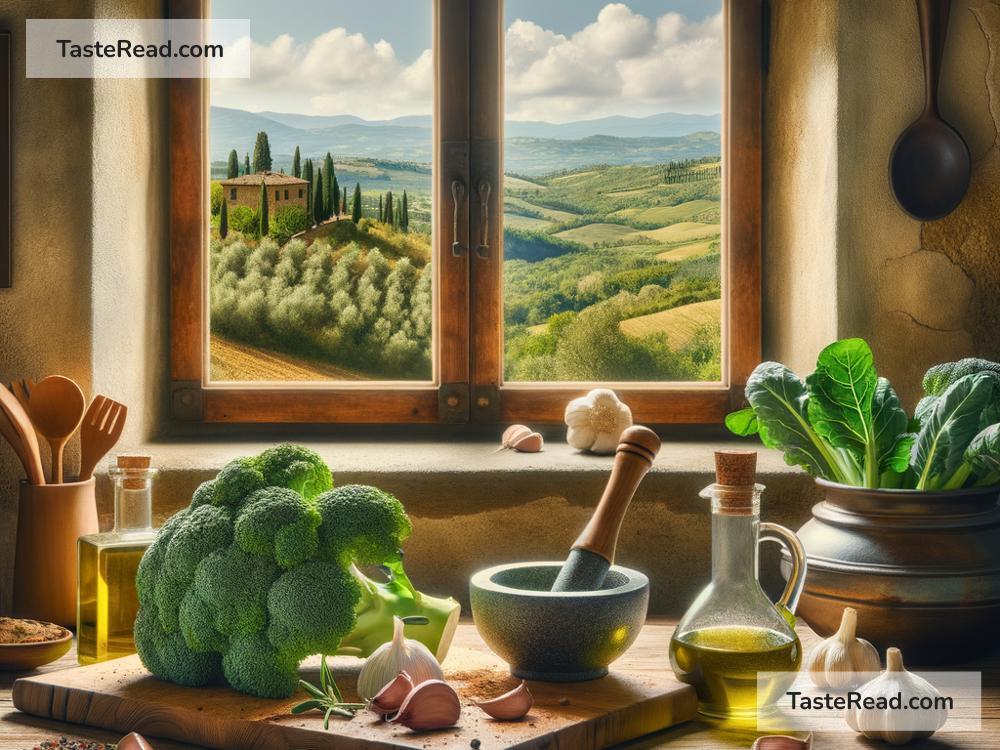The Curious Story of Broccoli in Italian Cuisine
Broccoli is one of the most loved vegetables in Italian cuisine. Its bright green color, unique flavor, and versatility make it a favorite ingredient in many traditional dishes. But have you ever wondered where it came from and how it became an important part of Italian cooking? The story of broccoli is fascinating and full of surprises!
What is Broccoli?
Broccoli belongs to the cabbage family (Brassicaceae) and is closely related to cauliflower, kale, and Brussels sprouts. Its name comes from the Italian word “broccolo,” which means “the flowering crest of a cabbage.” This name fits perfectly, as broccoli is actually the flower of the plant, harvested before it fully blooms.
Broccoli is not just a vegetable; it’s a symbol of health and nutrition. It is packed with vitamins and minerals, including Vitamin C, Vitamin K, fiber, and antioxidants. This makes it not only delicious but also great for keeping the body strong.
The Origins of Broccoli
While broccoli is now associated with Italian cooking, it didn’t originally come from Italy. Its roots go all the way back to ancient civilizations. Historians believe that broccoli was first cultivated over 2,000 years ago in the Mediterranean region, possibly in Greece or the Middle East. Early versions of broccoli were likely much smaller and more wild-looking than the broccoli we know today.
The ancient Romans were among the first to recognize broccoli’s potential. They loved its taste and believed in its health benefits. It was common to see broccoli prepared with olive oil, garlic, and spices — flavors that continue to define Italian cuisine.
Broccoli Becomes Italian
Although broccoli existed long before Italy became famous for its food, it was the Italians who perfected the vegetable and incorporated it fully into their cuisine. By the Middle Ages, farmers in Italy began cultivating broccoli more widely, especially in regions like Sicily, Calabria, and Campania. They experimented with new farming techniques to improve its size, flavor, and appearance.
Italian farmers were skilled at creating variations of vegetables, and broccoli was no exception. Over time, they developed different types of broccoli, including “broccolo romano,” a stunning variety with a spiral pattern, and “cime di rapa,” which is similar to broccoli but has thinner stalks and smaller leaves. These varieties became staples in Italian kitchens.
By the Renaissance period, broccoli was deeply rooted in Italian tradition. Famous Italian figures, including Catherine de’ Medici, were said to enjoy broccoli at royal feasts. Catherine even introduced broccoli to the French court when she married King Henry II of France in the 16th century. However, the vegetable didn’t gain immediate popularity outside of Italy.
Broccoli Crosses the Ocean
Broccoli stayed mostly in Italy for centuries before traveling to other parts of the world. In the 18th and 19th centuries, Italian immigrants brought their love of broccoli with them when they moved to places like the United States. Americans were initially unfamiliar with broccoli, but over time, it gained popularity thanks to its nutritional value and the Italian recipes that highlighted its taste.
The vegetable truly blossomed in American cuisine during the 20th century. The rise of Italian-American communities introduced dishes like pasta with broccoli, broccoli rabe sautéed in garlic, and broccoli in rich casseroles. These dishes became household staples, showcasing how one vegetable can bridge cultures.
Broccoli in Modern Italian Cuisine
Today, broccoli is a cherished part of Italian cooking. It can be found in nearly every part of Italy, used in a variety of dishes that range from simple peasant meals to refined restaurant plates. Italians appreciate broccoli for its ability to pair well with other ingredients, whether it’s mixed with pasta, baked in pies, or roasted alongside meats.
One traditional Italian dish featuring broccoli is orecchiette con cime di rapa, a pasta dish from the Puglia region. It’s made with small ear-shaped pasta, sautéed broccoli rabe, garlic, olive oil, and sometimes anchovies or chili flakes. The dish is simple yet incredibly flavorful, capturing the heart of Italian cooking.
Another favorite is broccoli al forno. In this dish, broccoli is baked in the oven with breadcrumbs, grated cheese, and sometimes béchamel sauce. The result is a crispy, cheesy creation that families enjoy during holiday dinners and celebrations.
In more recent times, Italians have embraced broccoli for its health benefits. With modern Italian cuisine focusing on fresh, nutritious ingredients, broccoli is often served lightly steamed or grilled to preserve its flavor and vitamins. It’s a popular addition to salads, soups, and even pizza!
Broccoli Around the World
Because of its connection to Italian immigrants, broccoli is widely enjoyed worldwide today. Restaurants around the globe offer Italian-inspired broccoli dishes, showing how even one humble vegetable can tell an amazing story.
From ancient Mediterranean fields to modern kitchens, broccoli has traveled through history, picking up flavors, traditions, and fans along the way. Its curious journey reminds us how food connects people and cultures, making it much more than just something to eat.
The next time you enjoy a broccoli dish, think about its story. Whether you’re eating a classic Italian recipe or a fusion creation, you’re sharing in a piece of history — one bite at a time!


